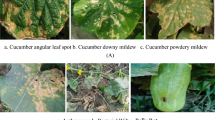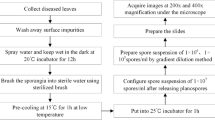Abstract
Anthracnose is a common disease that affects crops, and rapid diagnosis using computer vision technology can reduce economic losses. The convolutional neural network is still the mainstream crop disease detection and disease spot segmentation method. However, the method based on the convolutional neural network is not suitable for the detection and segmentation tasks with minor differences between crop lesions. In view of the instance characteristics that anthracnose lesions are mostly large in size, different in size, and regular in shape, the Path Aggregation Swin Transformer Network (PAST-Net), is proposed to achieve lesion segmentation and species detection of anthracnose simultaneously. First, the Swin Transformer is used as the backbone to extract features of input images. Second, the extracted lesion features are sequentially sent to the top-down feature pyramid network and the bottom-up augmentation path to retain the shallow network features to the greatest extent and improve the extraction ability of large-sized lesions. Next, the same proposal features from all levels are integrated using adaptive feature pooling. Finally, the box branch performs classification and bounding box regression, while the mask branch performs lesion segmentation. Experimental results show that PAST-Net improves the performance of both object detection and instance segmentation on the collected anthracnose dataset, with a recognition accuracy of 73.70% and a segmentation accuracy of 75.35%, which are 5.86% and 3.57% higher than the baseline, respectively.









Similar content being viewed by others
Data availability
Data are available from the authors upon request.
References
Oliveira Silva, Ad., Aliyeva-Schnorr, L., Wirsel, S.G.R., Deising, H.B.: Fungal pathogenesis-related cell wall biogenesis, with emphasis on the maize anthracnose fungus Colletotrichum graminicola. Plants 11(7), 849 (2022)
Ma, J., Zheng, F., Zhang, L., Sun, Z., et al.: Disease recognition system for greenhouse cucumbers based on deep convolutional neural network. Trans. Chin. Soc. Agric. Eng. 34(12), 186–192 (2018)
Wang, Z., Shi, Y., Li, Y.: Segmentation of corn leaf diseases based on improved fully convolutional neural network. Comput. Eng. Appl. 55(22), 127–132 (2019)
Zhang, J., Kong, F., Wu, J., Zhai, Z., Han, S., Cao, S.: Cotton disease identification model based on improved VGG convolution neural network. J. China Agric. Univ. 23(11), 161–171 (2018)
Ozguven, M.M., Adem, K.: Automatic detection and classification of leaf spot disease in sugar beet using deep learning algorithms. Phys. A 535, 122537 (2019)
Kukreja, V., Dhiman, P.: A deep neural network based disease detection scheme for citrus fruits. In: 2020 International Conference on Smart Electronics and Communication (ICOSEC), pp. 97–101 (2020). IEEE
Long, J., Shelhamer, E., Darrell, T.: Fully convolutional networks for semantic segmentation. In: Proceedings of the IEEE Conference on Computer Vision and Pattern Recognition, pp. 3431–3440 (2015)
Noh, H., Hong, S., Han, B.: Learning deconvolution network for semantic segmentation. In: Proceedings of the IEEE International Conference on Computer Vision, pp. 1520–1528 (2015)
Ronneberger, O., Fischer, P., Brox, T.: U-net: Convolutional networks for biomedical image segmentation. In: International Conference on Medical Image Computing and Computer-assisted Intervention, pp. 234–241 (2015)
Badrinarayanan, V., Kendall, A., Cipolla, R.: Segnet: a deep convolutional encoder-decoder architecture for image segmentation. IEEE Trans. Pattern Anal. Mach. Intell. 39(12), 2481–2495 (2017)
Chen, L.-C., Papandreou, G., Kokkinos, I., Murphy, K., Yuille, A.L.: Semantic image segmentation with deep convolutional nets and fully connected crfs. arXiv preprint arXiv:1412.7062 (2014)
Chen, L.-C., Papandreou, G., Kokkinos, I., Murphy, K., Yuille, A.L.: Deeplab: semantic image segmentation with deep convolutional nets, atrous convolution, and fully connected crfs. IEEE Trans. Pattern Anal. Mach. Intell. 40(4), 834–848 (2017)
Chen, L.-C., Papandreou, G., Schroff, F., Adam, H.: Rethinking atrous convolution for semantic image segmentation. arXiv preprint arXiv:1706.05587 (2017)
Zhao, H., Shi, J., Qi, X., Wang, X., Jia, J.: Pyramid scene parsing network. In: Proceedings of the IEEE Conference on Computer Vision and Pattern Recognition, pp. 2881–2890 (2017)
He, K., Gkioxari, G., Dollár, P., Girshick, R.: Mask r-cnn. In: Proceedings of the IEEE International Conference on Computer Vision (ICCV), pp. 2961–2969 (2017)
Ren, S., He, K., Girshick, R., Sun, J.: Faster r-cnn: Towards real-time object detection with region proposal networks. Advances in neural information processing systems 28 (2015)
Liu, S., Qi, L., Qin, H., Shi, J., Jia, J.: Path aggregation network for instance segmentation. In: Proceedings of the IEEE Conference on Computer Vision and Pattern Recognition, pp. 8759–8768 (2018)
Kolesnikov, A., Dosovitskiy, A., Weissenborn, D., Heigold, G., Uszkoreit, J., Beyer, L., Minderer, M., Dehghani, M., Houlsby, N., Gelly, S.: An image is worth 16x16 words: Transformers for image recognition at scale. arXiv preprint arXiv:2010.11929 (2020)
Zheng, S., Lu, J., Zhao, H., Zhu, X., Luo, Z., Wang, Y., Fu, Y., Feng, J., Xiang, T., Torr, P.H.: Rethinking semantic segmentation from a sequence-to-sequence perspective with transformers. In: Proceedings of the IEEE/CVF Conference on Computer Vision and Pattern Recognition, pp. 6881–6890 (2021)
Liu, Z., Lin, Y., Cao, Y., Hu, H., Wei, Y., Zhang, Z., Lin, S., Guo, B.: Swin transformer: Hierarchical vision transformer using shifted windows. In: Proceedings of the IEEE/CVF International Conference on Computer Vision, pp. 10012–10022 (2021)
Cao, H., Wang, Y., Chen, J., Jiang, D., Zhang, X., Tian, Q., Wang, M.: Swin-unet: Unet-like pure transformer for medical image segmentation. arXiv:abs/2105.05537 (2021)
Sun, Z., Liu, C., Qu, H., Xie, G.: A novel effective vehicle detection method based on swin transformer in hazy scenes. Mathematics (2022). https://doi.org/10.3390/math10132199
Gao, Z., Wei, H., Guan, W., Nie, J., Wang, M., Chen, S.: A semantic-aware attention and visual shielding network for cloth-changing person re-identification (2022). https://doi.org/10.48550/arXiv.2207.08387
Zhao, Y., Zhang, H., Gao, Z., Guan, W., Nie, J., Liu, A., Wang, M., Chen, S.: A temporal-aware relation and attention network for temporal action localization. IEEE Trans. Image Process. 31, 4746–4760 (2022)
Hu, H., Gu, J., Zhang, Z., Dai, J., Wei, Y.: Relation networks for object detection. In: Proceedings of the IEEE Conference on Computer Vision and Pattern Recognition, pp. 3588–3597 (2018)
Krizhevsky, A., Sutskever, I., Hinton, G.E.: Imagenet classification with deep convolutional neural networks. Advances in neural information processing systems 25 (2012)
Russell, B.C., Torralba, A., Murphy, K.P., Freeman, W.T.: Labelme: a database and web-based tool for image annotation. Int. J. Comput. Vis. 77(1), 157–173 (2008)
Ruder, S.: An overview of gradient descent optimization algorithms. arXiv preprint arXiv:1609.04747 (2016)
He, K., Zhang, X., Ren, S., Sun, J.: Deep residual learning for image recognition. In: Proceedings of the IEEE Conference on Computer Vision and Pattern Recognition, pp. 770–778 (2016)
Xie, S., Girshick, R., Dollár, P., Tu, Z., He, K.: Aggregated residual transformations for deep neural networks. In: Proceedings of the IEEE Conference on Computer Vision and Pattern Recognition, pp. 1492–1500 (2017)
Sun, K., Xiao, B., Liu, D., Wang, J.: Deep high-resolution representation learning for human pose estimation. In: Proceedings of the IEEE/CVF Conference on Computer Vision and Pattern Recognition, pp. 5693–5703 (2019)
Lee, Y., Hwang, J.-w., Lee, S., Bae, Y., Park, J.: An energy and gpu-computation efficient backbone network for real-time object detection. In: Proceedings of the IEEE/CVF Conference on Computer Vision and Pattern Recognition Workshops, pp. 0–0 (2019)
Acknowledgements
This work was supported in part by NSFC (U1931207 and 61702306), Sci. & Tech. Development Fund of Shandong Province of China (ZR2022MF288, ZR2017MF027 and ZR2022MF319), and the Taishan Scholar Program of Shandong Province.
Author information
Authors and Affiliations
Corresponding authors
Ethics declarations
Conflict of interest
The authors declare that they have no conflict of interest.
Ethical approval
This paper contains no cases of studies with human participants performed by any of the authors.
Additional information
Publisher's Note
Springer Nature remains neutral with regard to jurisdictional claims in published maps and institutional affiliations.
Rights and permissions
Springer Nature or its licensor (e.g. a society or other partner) holds exclusive rights to this article under a publishing agreement with the author(s) or other rightsholder(s); author self-archiving of the accepted manuscript version of this article is solely governed by the terms of such publishing agreement and applicable law.
About this article
Cite this article
Wang, Y., Wang, S., Ni, W. et al. PAST-net: a swin transformer and path aggregation model for anthracnose instance segmentation. Multimedia Systems 29, 1011–1023 (2023). https://doi.org/10.1007/s00530-022-01033-2
Received:
Accepted:
Published:
Issue Date:
DOI: https://doi.org/10.1007/s00530-022-01033-2




